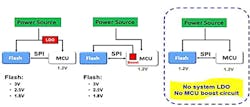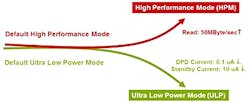Ultra-Low-Power Chips Expedite Energy-Efficient Designs
What you’ll learn:
- Why ultra-low-power flash memory and microcontrollers matter, efficiency-wise.
- What markets represent the greatest demand for ULP devices, and why.
- How the semiconductor industry is reducing overall power consumption in products.
The semiconductor industry is working diligently on reducing overall power consumption in end systems. A telling indicator of this trend can be found in the microcontroller (MCU) market, in which ultra-low-power (ULP) MCUs made up 32% of all MCUs shipped in 2020. That share is expected to exceed 70% by 2027.
The shift to ultra-low power can be seen in a broad range of markets and applications. Notable among them are medical devices, wearables, industrial systems, and the Internet of Things (IoT), which rely on MCUs.
Microcontrollers are essential to those applications, and to support them, MCUs must continuously find ways to improve power efficiency. One way is through the continuous shrinking of process nodes to provide an increase in logic, SRAM, and analog densities, as well as enhancements in performance—all while maintaining the same power consumption, if not achieving a net reduction in power. In other words, dies are getting smaller, and using less power, while delivering higher performance.
To accomplish these design and market goals, semiconductor manufacturers are investing in new technologies such as FinFET (1x nm~x nm). This transistor technology change from MOSFET (1xx nm~2x nm) provides an MCU measuring 100 mm2 at 45 nm the ability to shrink to less than 20 mm2 at 14 nm—an astounding 80% reduction. With this decrease in dimension, less power is required and performance surges.
The delicate balancing act of power efficiency and performance is particularly important in the medical electronics market, where the wearable devices segment is expected to experience a 24% annual compound annual growth rate (CAGR) between 2021-2025. With the increase in remote care and an aging population and healthcare becoming more accessible globally, the medical devices industry is trending toward more patients wearing electronic devices to aid in diagnoses and treatments.
Patient-wearable devices require various sensors to continuously read, monitor, and process data sets, as well as be able to transmit data to remote secure cloud storage facilities. Due to the extra components necessary to provide such functionality, coupled with the restrictions that come with being a wearable device, their consumption of power must be kept to a minimum to maximize battery life.
Another fast-growing space that’s clamoring to reduce power is the industrial market, in which IoT devices are expected to reach nearly 31 billion by 2025—double the 2021 figure. This should come as no surprise considering the trends toward industrial automation and smart manufacturing, both ushering in what’s known as Industry 4.0.
The above examples point to an incontrovertible shift toward lower power. Let’s look at the factors driving lower power, the benefits of transitioning to it, and the software supporting it.
Shrinking Nodes Shrink Power Needs
In addition to the dramatic reduction in die sizes and manufacturing processes cited above, the core voltage and I/O supply voltage also is dropping from 1.2 V/1.8 V (4x nm) to 0.8 V/1.2 V (1x nm). This voltage change significantly decreases power consumption, since P(t) = I(t) * V(t).
To capitalize on the potential power savings due to lower I/O supply voltages, external IC components also must align with this supply voltage. If successfully designed, it presents tremendous opportunities for devices, particularly in the wearable market, to maintain their portability, while being able to last longer in the field between battery charges.
When MCUs transition to a 1.2-V supply, other peripherals such as flash devices, EEPROM, and RAM are encouraged to make this shift as well to reduce the overall system power consumption and increase battery life. The system is able to conserve power when the peripheral components’ input voltages match the MCU. That’s because the system no longer requires additional components such as low-dropout regulators (LDOs), voltage regulators, or other forms of boost circuitry, which by design are impossible to be 100% efficient.
Eliminating these additional components leads to several advantages, such as a less-complex overall design, more room in the power budget, a simpler circuit-board layout, and a lower bill of materials (BOM). Figure 1 illustrates these advantages. Not only would a system architect’s design become easier to maintain, but by eliminating these components, the device also would last longer in the field, shrink in overall size, and ultimately cost less to produce.
Using 3.3-V /1.8-V MCUs in battery-operated designs may lead to a larger battery size and might require higher-rated batteries. However, shifting toward a 1.2-V (from 3 V or even 1.8 V) architecture will give portable solutions the flexibility to reduce the battery size, resulting in a simpler design, fewer components on a less-populated board layout, smaller battery and/or longer battery life, and, again, a reduced BOM.
With respect to lower BOM, Macronix’s external flash solutions, for example, present a viable option because embedded flash isn’t able to cost-effectively shrink below 40 nm. Therefore, as the rest of the system continues to shrink, embedded flash becomes relatively more expensive, rendering it less viable in advanced process nodes for many cost-sensitive applications.
Hence, Macronix’s MX25S series ULP flash-memory solution is experiencing increased demand. It addresses the need for low power through its 1.2 V(1.14 V~1.6 V) for ULP consumption (1.65 mA ICC_active, 0.05 µA ICC_dpd). The memory effectively extends a device’s battery life due to lower voltage operation and lower current consumption.
Power Management is Essential to Energy Efficiency
The wide deployment of IoT is driving microcontrollers to embrace ULP, which not only reduces dynamic run power, but also offers a range of power modes. In some implementations, sub-microamp current consumption is possible.
It’s not just the MCU that has the potential for enabling a low-power system, especially for portable and IoT designs. These types of systems also consist of power-management integrated circuits (PMICs), memory, a battery, and other components that also benefit from power-saving improvements.
In response to the demand for better power efficiency, nonvolatile flash has evolved to incorporate power-management features. For example, Macronix developed the MX25R and MX25S to enable users to maximize their architecture so that they can be geared toward low-power applications without sacrificing performance.
Both solutions offer mode selection to switch back and forth between the ULP and high-performance modes, thus saving power and handling critical tasks dynamically. Figure 2 illustrates the tradeoffs between ULP and high-performance modes.
In ULP mode, both the standby current and deep-power-down leakage are dramatically reduced. The standby current is only a single-digit microampere, while the leakage of deep power down is a mere one percent of that. Still, users can quickly revert to high-performance mode within microseconds to handle mission-critical scenarios by leveraging more than 50-MB/s throughput. The active currents of different operations in the ULP mode also are reduced to only about 50% of those in the high-performance mode.
Multi-I/O Means More Flexibility in Flash Performance
Multi-I/O technology has given a significant boost to serial flash performance while maintaining the backward compatibility with the conventional Serial Peripheral Interface (SPI) protocol. Such backward compatibility provides scalable performance, enabling users when necessary to revert to a single I/O protocol to reduce both peak and average current drain. It then effectively pushes off the cell voltage drop if powered by a battery.
A set of different command codes are included, simplifying I/O scaling through a software implementation that employs different commands accordingly (Fig. 3).
Flash Frequency Scaling
Another useful scheme to control current consumption is frequency scaling. It’s well-known among system designers that dynamic power is proportional to the operating frequency and current. With the ability to adjust the frequency, users can operate at different rates to mitigate current consumption when accessing flash through the SPI.
In addition, when switching to ULP mode, both the peak and average current are further reduced because the embedded operation flows and clock management are precisely handled.
Power on Demand
The three major hardware features mentioned above make up managed flash and excel in power-sensitive applications. In addition, a hardware abstraction layer (HAL) with an application programming interface (API) is usually provided to accompany the hardware, allowing for maximum power optimization. Users can develop their applications by embedding power states and making API calls to precisely manage power.
To illustrate this, Macronix developed a reference flash driver to support applications employing different modes for power management, according to design requirements. For example, the MxChangeMode command can be used for applications switching among various modes, including SPI, dual SPI, Quad SPI, and DDR.
MxDeepPowerDown and MxRealseDeepPowerDown API calls are used when an application needs to enter or exit deep-power-down mode, which is the most power-saving state, using only tenths of a microampere of current consumption.
Conclusion
MCUs continue to evolve to adapt to market needs, and lower power is one of the critical elements of that evolution impacting countless industries. Key applications such as medical devices, wearables, industrial systems, and the IoT are the first to drive this shift, especially for lower core voltages such as 1.2 V, as well as the need for smaller and mobile solutions.
MCU vendors will continue to push the envelope to smaller technology nodes and lower core voltages. To support this push from a system perspective, peripheral components must lower their operating voltages to match those of MCU vendors to maximize the potential power savings. In addition to MCUs and peripheral components, system designers need to consider power-management features offered in devices, such as flash memory that has functions like mode switching, accessing Multi-IO, and frequency scaling, as cited above.
It's an exciting time to be developing ULP products, as the industry continues to progress to best address this growing market.



